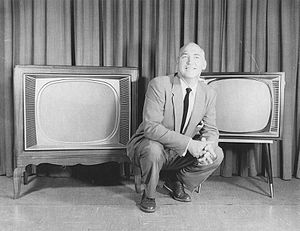Frank Cook (industrial designer)
Frank Edward Cook, Sr. (July 23, 1914 – June 27, 2003[1]) was an American industrial designer and artist who helped define the shape for radio and television, as a leading resident designer for the Radio Corporation of America[2] for over two decades. He is best known today for modern radios and televisions for RCA. Frank became a specialist in the industrial design field, specializing in the engineering, design and style of cabinets or cases for television, radio, phono and allied electronic devices.
Background[edit]
Frank Edward Cook was born July 23, 1914, in Camden, NJ, to George and Serena Sattler (Sadler) Cook. Frank married Laura Clara Kurpicki on October 6, 1934, at St. Joseph's Church in Camden, NJ. Frank and Laura had three children: Serena Anne, Frank Edward Jr., and Laura Lee.
Frank attended the Henry L. Bonsall Elementary School, Camden, New Jersey, 1928, Cooper B. Hatch Middle School, Camden Senior High, 1932, School of Industrial Arts (Museum School of Art), 1938, Indiana University Center For Art and Design (Evenings), 1941–1943, RCA Bloomington, IN, Course (Industrial Plastics) as instructor, 1943, RCA Camden, NJ, Course (Manufacturing and Production Methods), 1954, RCA Cherry Hill, NJ, Art Instruction (instructor), 1956.
Frank was a member of the Industrial Designers Institute (Program chairman 1955–1956), Industrial Designers Society of America, and the Society of Plastics Engineers.
Frank was an avid outdoorsman with a passion for fresh water fishing, salt water fishing, small game hunting, and deer hunting in New Jersey, Pennsylvania, and New York. He was among a number of local fishing and hunting enthusiasts who organized the "ESOX Rod & Gun Club of New Jersey" and the "Surf N Land Sportsman's Club Pennsauken New Jersey", where he designed the clubs' logo used for stationary and club patches.
Industrial design[edit]
From 1939 – 1941, Frank worked at the RCA Manufacturing Company, in Camden, New Jersey, as an Engineering Stylist in the Styling Department, Home Instrument Section, where he designed and styled table models, combination table and console models and portable types for radio and phonograph. Frank transferred to RCA Victor Division of RCA, Bloomington, Indiana.
From 1941 – 1944, Frank worked at the RCA Victor Division of RCA, Bloomington, Indiana, as an Industrial Designer/Engineering Stylist, responsible for all styling activity in the division. He designed and styled table models, combinations and portable cabinets or cases for radio and phonograph. This plant specialized in the manufacture and assembly of the table type radio and phonograph equipment. In 1944 the Engineering Department and Frank were relocated back to Camden, NJ.

From 1944 – 1960, Frank worked at the RCA Victor Division of RCA, Camden, New Jersey, as a senior Industrial Designer (RCA Classification) in the Styling Department, Product Development Division, Home Instrument Section, where he was responsible for concept, style, and design (engineer) of radio cabinets (wood) and cases Metal and Plastics material) in phono and phono-radio combination cabinets and cases in table, portable and console types, television cabinets and cases in table, console, console combinations and portable types. The designs included all kinescope diameters, direct view and projection systems in black and white and in color. Included also would be the allied accessories such as table television stands and bases, mask treatments, design of controls and control boxes, glass retainers, etc. During his time at the Radio Corporation of America, Frank worked with and socialized with many of the pioneers of television technology, including Vladimir K. Zworykin, David Sarnoff, and John Vassos.
During his 20+ years working for RCA, Frank participated in a great number "firsts" in the evolution of television. He personally designed the first table and console type cabinets incorporating the 7", 10", 12", 14", 21", 23", and 27" kinescope;[3] the first portable cases for the 10" and 14" kinescope; the first table and console type cabinets for the original color kinescope; and "firsts" in the design of television accessories such as masks, controls, and remote controls.

From 1960 – 1972, Frank continued his work as an Industrial Designer for a number of companies competing in radio, and television production in North America, including Philco Corporation, Philadelphia, Pennsylvania, Emerson Radio and Phonograph Corporation, Jersey City, New Jersey, Symphonic Electronic Corporation, New York City, and Fisher Electronics, Long Island City, New York.
From 1972 until his retirement in 1976, Frank continued as a Design Draftsman for Holley Associates, Moorestown, New Jersey, TYCO Industries, Inc., Moorestown, New Jersey, and Wheaton Plastics Company, Mays Landing, New Jersey.
Art[edit]

Frank always had a passion and talent for artistic impression. He worked in virtually all mediums, including pen-and-ink, watercolor, charcoal, pastel, oil, and acrylic. He painted and sketched portraits, still lifes, landscapes, and seascapes. His landscapes and seascapes were inspired from his travels to his favorite locations in New Jersey and along the New England and Southern California coasts. He was particularly interested in capturing some of the Southern New Jersey historic sites like the Weymouth Furnace and the Penny Pot Dam.
While working at RCA, Frank shared his artistic talent by holding adult education art classes for RCA employees.
References[edit]
- ↑ "Obituary".
- ↑ "RCA (Radio Corporation of America)". IEEE Global History Network.
- ↑ "The TV Years". Early History of TV.
External links[edit]
Sources[edit]
- Family Archive of personal employment resume, diaries, and notebooks
- Family Archive of RCA corporate photographs
- Archive of drawings and dies of logo for the "ESOX Rod & Gun Club of New Jersey" and the "Surf N Land Sportsman's Club Pennsauken New Jersey"
- Personalized and signed copy of "Dogs Are Like That" by John Vassos
This article "Frank Cook (industrial designer)" is from Wikipedia. The list of its authors can be seen in its historical. Articles copied from Draft Namespace on Wikipedia could be seen on the Draft Namespace of Wikipedia and not main one.
